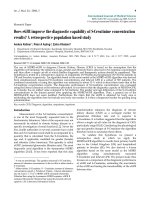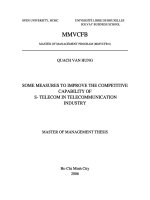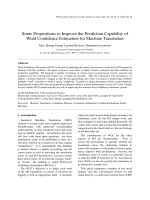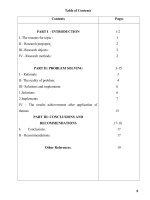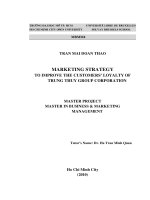Some measures to improve the competitive capability of S Telecom in telecommunication industry
Bạn đang xem bản rút gọn của tài liệu. Xem và tải ngay bản đầy đủ của tài liệu tại đây (1.61 MB, 99 trang )
First of all, I would like to say thank you from bottom of my heart to the
Managing Board of Open University, Ho Chi Minh City and Solvay Business School,
Belgium for cooperating and opening Master of Management syllabus. I myself have
studies a lot from the systematic way of evaluation to realistic knowledge. The most
important thing I learnt is enthusiasm, knowledge of Professors and true values of
studying.
Secondly, I would like to express the deep thanks to Vice Professor, Doctor
who is very enthusiastic and devoted to help and to
mentor me in researching and writing this thesis. In addition, I would like to thank
Professor
who has taught me Strategic Management course,
cared and given me advices in writing this thesis.
Next, I’d like to express my deep gratitude to my colleagues at
who help me to complete this thesis.
Finally, I’d like to wish Professor healthy and successful. I wish this
cooperation is more and more fruitful and provides society with useful and true
talents in order to help Viet Nam stronger and prosperous.
Writer
With the thesis named, “Some measures to improve the competitive capacity of S-
Telecom in telecommunication industry”, the writer, Quach Van Hung has finished it
with following successes:
1- The theory of competition, competitive capacity and competition model is
introduced completely and creates the strong base for analysis and suggested
measures in later chapters.
2- The analysis of S-Telecom operation is done comprehensively from general
environment to industry environment by 5 competitive forces model. The
writer has analyzed SWOT matrix, value chain of S-Telecom to find the
competitive advantages and disadvantages in competition.
3- The system of measures is suggested matching with analyzed content. The
proposed system of measures serves objectives and development plans of S-
Telecom rather well.
4- This thesis is with high scientific content, measures are applicable and
practical. In my opinion, this thesis is rated excellently.
Page
: General view about competition theory 1
1.1 Concept of competition and Competitive capability 1
1.1.1 The concept of competition 1
1.1.2 Competitive capability 1
1.1.3 Factors influencing competitive capability 2
1.2 Introducing Michael Porter Five Forces Model 3
1.2.1 New entrants 4
1.2.2 Rivalry 5
1.2.3 Customers 6
1.2.4 Suppliers 6
1.2.5 Substitutes 7
7
: Analysing the operations of S-Telecom in the telecommunication
industry 8
2.1 – S-Telecom overview 8
2.1.1 Creation and development process of S-Telecom 8
2.1.1.1 History of establishment 8
2.1.1.2 Operation professions 9
2.1.1.3 Project objectives, scale and scope 9
2.1.1.4 CDMA technology introduction 10
2.1.2 Vision and Mission 12
2.1.3 Organizational structure of S-Telecom 13
2.1.3 Business Results of S-Telecom over past years 14
2.1.3.1 Subscriber development 14
2.1.3.2 Financial results 15
2.2 – Analysing the competitive environment of S-Telecom 20
2.2.1 General environment 20
2.2.1.1 Economic factors 20
2.2.1.2 Political and Legal factors 20
2.2.1.3 Social factors 22
2.2.1.4 Technological factors 23
2.2.1.5 Natural factors 23
2.2.2 Industry environment 23
2.2.2.1 Rivalry among competing companies 23
2.2.2.2 Customer 32
2.2.2.3 Suppliers 33
2.2.2.4 Subsitutes 34
2.2.3 SWOT analysis 35
2.3 – Analysing the value chains of S-Telecom 38
2.3.1 Primary activities 39
2.3.2 Support activities 40
42
: Measures to improve the competitive capability of S-Telecom 47
3.1 Proposing new vision and mission based on competitive analysis 47
3.2 Suggested measures based on the analysis of Company value chains 48
3.2.1 Structure and Operations 48
3.2.1.1 Change organization structure 48
3.2.1.2 Reeneering processes 50
3.2.1.3 Building customer focused culture 51
3.2.2 Marketing Strategy 52
3.2.2.1 Handsets and services 52
3.2.2.1.1 Diversifying handsets to have good and affordable ones 52
3.2.2.1.2 Widening network coverage and upgrading quality 53
3.2.2.1.3 Diversifying services and providing VAS based on CDMA 54
3.2.2.2 Pricing strategy 55
3.2.2.2.1 Renewing and updating price strategy 55
3.2.2.2.2 Designing attractive tariff aiming at low ARPU segment 56
3.2.2.2.3 Adjusting prepaid card duration 57
3.2.2.2.4 Discounting for customers using large volume 57
3.2.2.2.5 Adjusting price of VAS 58
3.2.2.3 Distribution channels 59
3.2.2.3.1 Expanding and upgrading distribution channels 59
3.2.2.3.2 Reenforcing and upgrading the quality of channels 60
3.2.2.4 Promotion activities 62
3.2.2.4.1 Building up the strong images in community 62
3.2.3 Human Resources Management 63
3.2.3.1 Building up proper recruitment and selection process 63
3.2.3.2 Training and retraining 65
3.2.3.3 Employee development 68
3.2.3.4 Building up remuneration policy 69
3.2.3.5 Improving the performance evaluation program 71
3.2.4 Customer Relationships Management 73
3.2.4.1 Building up the strong commitment 74
3.2.4.2 Identifying and treating customers differently 75
3.2.4.3 Improving processes and reducing transaction cost of customer 76
3.2.4.4 Building up communication channels 82
83
For a long time, Telecommunication was a monopoly industry which restricted
competition and limited the choice of customer. Since 1995, the policy and
regulations related were got loose which permitted many companies taking part in
and providing services. As a result, the number of service providers are increasing to
six from two operators. Especially, when Viet nam becomes the official member of
WTO, there will be many international corporations with the strength of financial,
technological, management experience joining Viet nam market. These are the
threat and opportunities for current firms.
Although S-Telecom was established and operated in Viet nam for many
years, it seemed that it cannot compete well due to internal and external factors.
Facing the threat and opportunities, there are only two choices,
in such a fierce competition. Of course, Korean investor not only want to be but
also develop because they invested a lot of money in this potential market. The
unique way for its survival and development is improving the competitive capability
of company.
Because of the attractiveness of the subject and the current fierce
competition, I chose the topic:
as my master thesis.
Based on the competion theory, this topic focuses on some basic matters as
follows:
ϖ Analysing the environment and its factors influencing competition.
ϖ Analysing and evaluating opportunities and threat from environment.
ϖ Analysing and evaluating the capability of S-Telecom in the communication
industry.
ϖ Suggesting some measures to improve the competitive capability of S-
Telecom in this industry.
This thesis just focuses on improving the capability of S-Telecom and doesn’t
have conditions to research and suggest common measures for all service providers.
In order to meet the above mentioned objectives, I used following method for
my thesis such as statistic, analyse, compare and social survey.
There are 3 main chapters in this thesis:
¬
Chapter 1
: General view about competion theory
¬
Chapter 2
: Analysing the competitive capability of S-Telecom in
communication industry.
¬
Chapter 3
: Some suggested measures to improve the competitive capability of
S-Telecom.
1
1.1.1 The concept of competition
The Vietnamese dictionary explains,” Competition is a concept which is used
in different fields. To simplifying, we can understand that competition is a rival
between parties so that whose position increased will lead to another’s decreased.
The required condition in market is that there are at least two parties who have
antagonistic relationship and correlativeness between the devotion and benefits of
each party in market”
1.1.2 Competitive capability
Competitive capability is a term that is widely used with different level such
as at national, company and product level. However, there is no clear concept as
well as common measure about it. Competitive capability is evaluated under
different views:
According to traditional commercial theory, competitive of one company is
evaluated through competitive advantages in cost and labor productivity. Company
which obtains high productivity and low cost will get competitive advantages,
dominate market with large revenue and high profit. This theory suggested that the
way to improve competitive capability is focusing on improving labor productivity
and reducing cost.
2
In Michael Porter’s view, companies now facing the fast development of
Internet and globalization movements should develop competitive advantage
including resources and capabilities. Resources of company are:
Tangible resources are assets that are seen and quantified such as financial
resources, organizational resources, physical resources and technological resources.
Intangible resources include assets that typically rooted deeply in the firm’s
history and have accumulated over time. They are human resources consisting of
knowledge, trust, managerial capabilities and organizational routines. They are
innovation resources including ideas, scientific capabilities and capability to
innovate. They are reputation resources comprising reputation with customers, brand
name, perceptions of product quality, durability, and reliability; reputation with
suppliers and for efficient, effective, supportive and mutually beneficial interactions
and relationships.
According to Michael Porter’s point of view, competitive capabilities are the
firm’s capability to deploy resources that have purposely integrated to achieve a
desired end state. These resources and capabilities will create core competencies
that serve as a source of a firm’s competitive advantage over rivals. They help to
distinguish a company competitively and reflect its personality.
For a capability to be a core competence, it must be valuable and non
substitutable from a customer’s point of view, and unique and inimitable, from a
competitor’s point of view.
1.1.3 Factors influence the formation of competitive advantages.
In classic economists’ view, factors of production like land, capital and labor
are considered as resources to form competitive advantage.
3
However, this theory didn’t explain the success of rose growing industry in
Holland with higher labor cost and land than others. It is difficult to understand Japan
is very famous for their machinery while it never possesses any mineral resources.
To explain this case, Michael Porter brought out the theory stated that the
availability of production factors and low cost were only one of available resources
formed competitive advantages and weren’t the critical factor if considered it on a
relative scale compared with others. The long term competitive advantage depends
much on the capability of continuous improving. Michael Porter underlined the
influence of national environment to implementation of continuous improvement in
company. He concluded that conditions of each country would have a great influence
on capability of improvement and competitive capability of company. They are:
− Conditions of production factors
− Conditions of demand
− Related and supporting industries.
− Strategy of company, industry structure, and competitive degree
− Opportunities and governmental policies.
Industry environment has direct influences on each business or company
compared with general environment. Michael Porter brought out the five forces of
competition model in order to help company analyze and define critical factors that
directly affect company operation. The five forces of competition are:
− Threat of new entrants
− Rivalry among competing firms
4
− Threat of substitute products
− Bargaining power of buyers
− Bargaining power of suppliers
Michael Porter said that influence of these forces will decide the investment
degree, competitive intensity and profit margin of industry. When they are stronger,
profit margin and ability to increase price are more limited. In opposite, when they
get weaker, they will allow company to gain more profit. According to view of
business strategy, manager should take these factors into account and pay more
attention to their threats before exploiting their opportunities.
1.2.1 Threats of new entrants
It’s difficult for companies to define new entrants. Identifying new entrants is
important because new entrants can threaten the market share of existing companies.
One reason is that they bring additional production capability. The ability to enter
market of new entrants is affected by two factors: barriers to entry and retaliation
expected from current industry participants.
Entry barriers make it difficult for new firms to enter an industry and often
place them at a competitive disadvantage even when they are able to enter. Several
kind of potentially significant entry barriers are:
− Economies of scale
− Product differentiation
− Capital requirements
− Switching costs
− Access to distribution channels
− Cost disadvantages independent of scales
5
− Government policy
Firms seeking to enter an industry also anticipate the reactions of firms in the
industry.
1.2.2 Intensity of rivalry among competitors
Because an industry’s firms are mutually dependent, actions taken by one
company usually invite competitive responses. The more intensive among
competitors, the less price consumers have to pay and the less profit they get. The
most prominent factors that experience shows to affect the intensity of firm’s
rivalries.
− Slow industry growth make firms battle to increase their market share by
attracting competitor’ customers.
− High fixed costs or high storage costs make companies try to maximize the
use of their productive capability. Doing so allows firm spread costs across a
larger volume of output. To then reduce inventories, individual companies
typically cut their price of their product and offer rebates and other special
discounts to customers. These practices often intensify competition.
− Numerous or equally balanced competitors
− Lack of differentiation or low switching costs
− High strategic stakes
− High exit barriers. Sometimes companies continue competing in an industry
even though the returns on their invested capital are low or negative. Common
exit barriers are:
¬ Specialized assets
¬ Fixed costs of exit
6
¬ Strategic relationships
¬ Emotional barriers
¬ Government and social restrictions
1.2.3 Bargaining power of buyers
Firms seek to maximize the return on their invested capital. Alternatively,
buyers want to buy products at the lowest possible price. To reduce their costs,
buyers bargain for higher quality, greater levels of service, and lower prices. These
outcomes are achieved by encouraging competitive battles among the industry’s
firms. Customers are powerful when
− They purchase a large portion of an industry’s total output
− The sales of the product being purchased account for a significant portion of
the seller’s annual revenues.
− They could switch to another product at little if any cost
− Products are undifferentiated or standardized.
1.2.4 Bargaining powers of suppliers
Increasing prices and reducing the quality of their products are potential
means used by suppliers to exert power over firms competing within an industry. If a
firm is unable to recover cost increases by its suppliers through its pricing structure,
its profitability is reduced by its suppliers’ actions. A supplier group is powerful
when
− The market is dominated by a few large companies.
− Satisfactory substitute products are not available.
− Industry firms are not a significant customer for the supplier group.
− Suppliers’ goods are critical to buyers’ marketplace success.
7
− High switching costs for industry firms because of the effectiveness of
suppliers’ products.
1.2.5 Threat of substitute products
Substitute products are goods or services from outside a given industry that
perform similar or the same functions as a product that the industry produces. In
general, product substitutes present a strong threat to a firm when customers face
few, if any, switching costs and when the substitute product’s price is lower or its
quality and performance capabilities are equal to or greater than those of the
competing product. Differentiating a product along dimensions that customer’s value
reduces a substitute’s attractiveness.
In general, this is the overview of competitive theory on two sides: company
internal factors to create competitive advantages and the five forces of competition
which affects directly the company competitive capability. It’s the base of arguments
to examine, identify, analyze and evaluate the competitive capability of S-Telecom
in telecommunication industry. As a result of analyzing, I will suggest some
measures to improve the competitive capability of S-Telecom in such current
situation.
8
2.1.1
Creation and development process of S-Telecom
2.1.1.1 History of establishment
The Ministry of Planning and Investment (MPI) issued license number
2223/GP dated 12 Sep 2001 to Saigon Postel Corporation (SPT) and SLD Telecom
Company which was set up in Singapore and consisting of SK Telecom, LG
Electronics and Dong Ah Elecomm. This collaboration aims at telecommunication
business in Viet Nam under BCC – Business Corporation Contract according to
Foreign Investment Law.
– Saigon Postel Corporation is the first stock company in Viet Nam
operating in Telecommunication industry and different fields such as import – export,
real estate, tourism, household appliances, production of IT, electronic and
telecommunication equipments. SPT is established under document number
7093/DMDN issued by Prime Minister on 8 December 1995 and officially set up
according to Decision number 2914/ GP-UB signed by People Committee of Ho Chi
Minh city. The business certificate number 064090 is issued by Department of
Planning and Investment of Ho Chi Minh city on October 17, 1996.
is a joint venture under BOT – Build Operate Transfer among
three Korean companies: SK Telecom, LG Electronics, and Dong Ah Telecomm.
This joint venture was set up in Singapore in October, 2000 and was considered as
one of the leading services provider of telecommunication industry in the world. In
2000, Asian Telecommunication Magazine chose SLD Telecom be one out of three
best companies which provide CDMA – Code Division Multiple Access in Asia.
9
is a project cooperated between SPT and SLD under BCC form
signed on 10 October, 2000 and provide telecommunication services and value
added application on CDMA 2000 – 1x nationwide. This contract is valid for 15 years
since receiving investment certificate.
2.1.1.2 Operating professions
ϖ
¬ Importing handsets of CDMA technology, spare parts and other
equipments in order to build telecommunication infrastructure.
¬ Trading and distributing CDMA handsets, registration card and prepaid
cards through nationwide channels of company.
ϖ
¬ Importing equipments and building BTS in provinces and cities of Viet
Nam in order to provide customers with high technological applications and
value added services.
2.1.1.3 Objectives, scale and scope of project
ϖ
¬ Cooperating to build, exploit and develop networks; providing
telecommunication services of CDMA technology on 800 MHz frequency in
Viet Nam. Network will be upgraded to 3
rd
generation technology and IS-2000
system.
¬ Providing voice services and other value added services on mobile
network such as fax, date transmitting, international calls, Internet in Viet
Nam.
ϖ
10
¬ Providing services for 700,000 to 1,000,000 subscribers.
¬ Designing, installing, and maintaining equipments.
¬ Providing high speed Internet services (ADSL)
¬ Upgrading to 3
rd
generation network and IS-2000 system from CDMA
2000 1x.
ϖ
¬ The total investment capital is 229,617,000 USD consisting working
capital and fixed capital. SPT’s capital contribution is the frequency exploiting
and using right, numbers, business license and working capital. SLD’s
contribution includes CAPEX and working capital.
2.1.1.4 technology introduction
ϖ
technology is the abbreviation of Code Division Multiple Access. This
technology allows customers connect simultaneously and signal is transmitted on the
same frequency. Subscriber channels are separated and coded by different random
codes. They are then mixed and transmitted on the same frequency and only restored
at correlative handsets.
CDMA technology was started with the birth of spectrum theory in 1950s with
a lot of advantages and applied in telecommunication of US Army. To 1980s, CDMA
technology was commercialized and officially suggested by Qualcom, one of the
leading telecommunication firms.
In 1995, CDMA IS – 95A was the first version commercialized in Hong Kong
through Hutchison with 14 Kbitz per second and was considered as the 2
nd
generation
system. CDMA dominated the market in the North of America in 1995. SK Telecom
11
and LG Telecom, the two leading telecommunication in Korea deployed the first
CDMA 2000 1x in the world in the year 2000 and the subscriber jumped from 127
million to 134 million in only three months.
ϖ
¬ Clear and reliable call quality because of applying voice coding. Voice
coding helps to limit jam and improve voice quality at the same level of cable
telecommunication.
¬ Reduce battery waste, increase time of conversation.
¬ High security because of using wide spectrum band.
¬ Providing voice services and data transmitting with high speed.
¬ Easy to deploy at lower cost and less BTS. The theoretical effects are 9
to 10 times higher than the same technology; it can receive and subscribe 3 to
5 times faster than GSM.
ϖ
– Global System for Mobile Communication and – Code
Division Multiple Access is the state of the art digital mobile system is applied
widely in the world now.
is the version of – Time Division Multiple Access, digital and
press data and then transmit to the channel via two different data flows in which each
flow occupied one time slot. The band at first divides into 200 KHz wave channel
and then separates channels based on time. The channel user will take turn one
another; therefore, there is one person for one channel and he can use it for a very
short time period.
12
is different from because after digitalizing, data are stretched on
the wide band. As a result, many calls can be connected simultaneously on the same
band. One voice bits identifies one specific code and this signal is transmitted on the
1.25 MHz band. CDMA allows managing the number of subscribers 5 to 20 times
higher than GSM with faster speed of data transmission. CDMA uses less battery and
have long time of conversation. Service radius of one BTS in CDMA technology is
bigger than GSM; it means less operating costs because of less BTS and saving for
both users and service providers but ensures the optimal quality of phone calls.
ϖ
International Telecommunication Union establishes the 3G concept with the
effort to unite the mobile technologies in the world. 3G systems should qualify the
strict criteria of mobile world. CDMA technology is highly evaluated because of
their voice and data transmission advantage. It provides services at low cost, high
security and more applications. There are absolutely opportunities that permit
remote and far areas approaching a whole new world of voice and data.
2.1.2 Vision and Mission of S-Telecom
2.1.2.1 Vision
Becoming one of the leading telecommunication service providers in Viet
nam by integrating communicating services, entertainment, business in
comprehensive and modern solution, with own character for customer and S-
Telecom.
2.1.2.2 Mission
ϖ Popularizing CDMA technology: building mobile network of CDMA
technology in nationwide.
13
ϖ Focusing on customer: every activity of S-Telecom directs to customer
satisfaction and their practical benefits.
ϖ Attracting and developing human resources: build working environment
professional, active and creative in order to contribute and build the solid S-
Telecom family as well as bring profits to partners.
ϖ Having strategic collaborations with partners: cooperate equally with partners
leading to the same success.
ϖ Constructing community: actively contributing and taking part in social
activities to make society brighter and better.
2.1.3 Organizational structure of S-Telecom ()
The special point in the organization of S-Telecom is the parallel mechanism
of management in which one side is Vietnamese Managers and other side is Korean
experts. Beside Vietnamese Chief Executive Officer – CEO, there will be the
Executive Advisor
. This structure exists at high level of management; as a result,
decisions are made if two parties involved all agree.
CEO is appointed by Vietnamese party and in charge of business operation
while Korean Experts play the role as Advisors although they really like to directly
manage the business. In reality, due to the lack of management experience and
knowledge in this technology, Vietnamese managers cannot make decisions or
manage this business well. The deep cause of this situation is of investment form –
BCC and telecommunication is the monopoly and sensitive industry that Vietnamese
government wants to keep control. Therefore, foreign investors can only enter
telecommunication industry under cooperation form and are not permitted to form
joint venture or 100% foreign capital companies.
